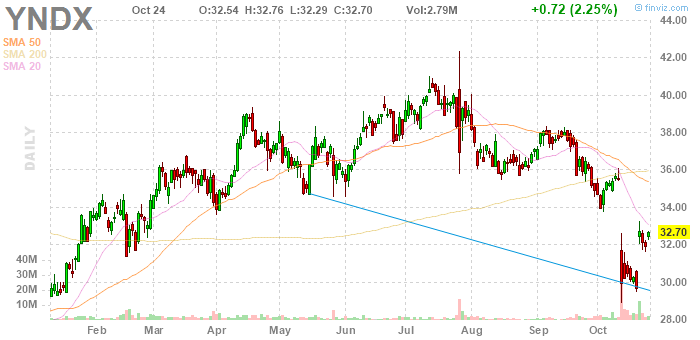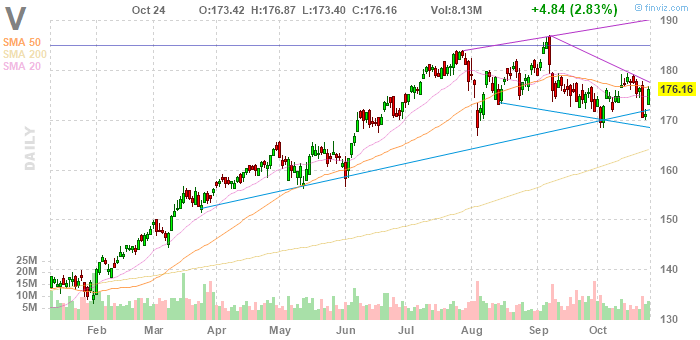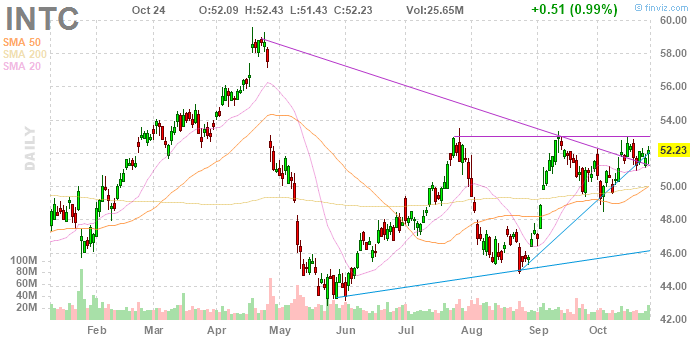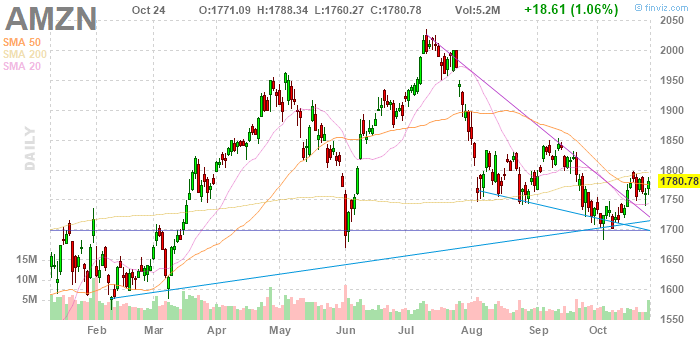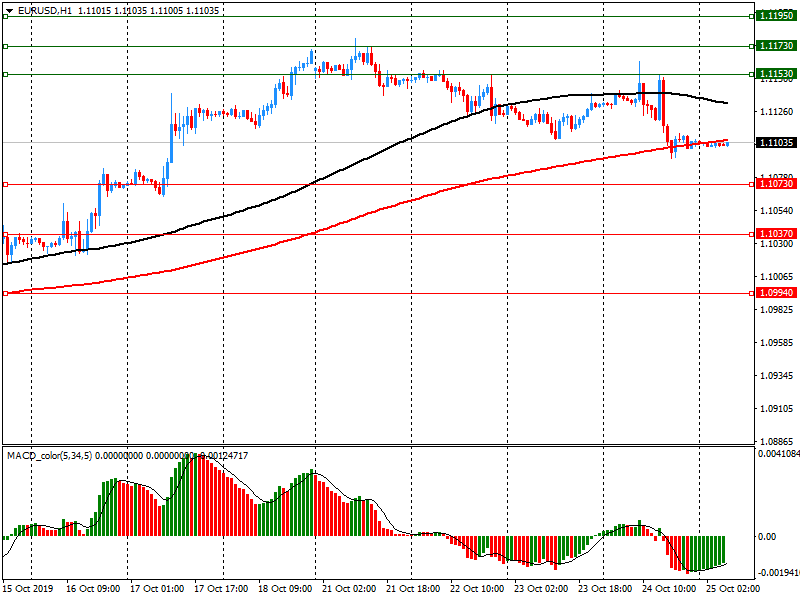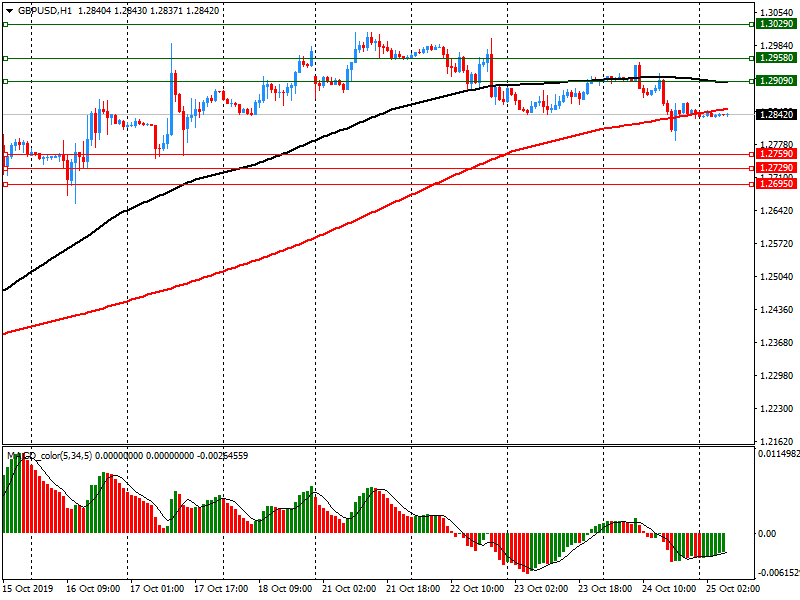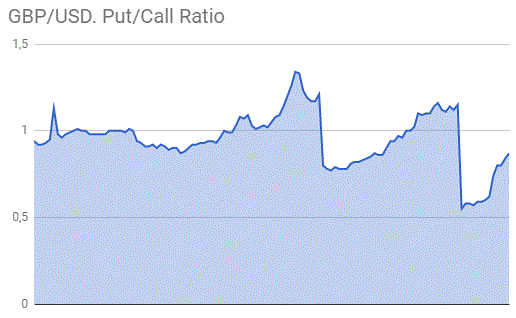- Analiza
- Novosti i instrumenti
- Vesti sa tržišta
Forex-novosti i prognoze od 25-10-2019
Dmitry Dolgin, the chief economist at ING, notes the Bank of Russia (CBR) has cut its key rate by 50bp to 6.5%, on the dovish side of analyst consensus but in line with more aggressive market expectations.
- "In our view, the CBR has increased the step from 25 to 50 bp today to highlight a material improvement in its near to medium-term inflationary expectations. Looking at the commentary, we see the CBR has:
- dropped the 'heightened inflationary expectations' phrase from the headline statement. Later, the text mentioned a disinflationary shift in the balance of near-term risks,
- lowered the YE2019 CPI forecast by 0.8pps from 4.0-4.5% to 3.2-3.7%,
- lowered the YE2020 CPI forecast by c.0.3pps from 4.0% to 3.5-4.0%,
- mentioned the increased role of weak demand on the CPI slowdown, which is helped by tighter-than-expected budget spending.
- We welcome the adjustment of the CBR's CPI expectations to reality and acknowledge that our own YE19 and YE20 CPI forecasts of 3.7% YoY and 4.0% YoY respectively seem conservative. We believe there are two key internal reasons why the CBR is now more confident in the favourable CPI trend:
- The government is struggling with allocating planned CAPEX spending; overall spending growth is 6% YoY as of 9M19 vs. 9% YoY according to the annual plan; As of 9M19, National Projects account for only 53% of the annual plan; local investments of the National Wealth Fund will be limited to 0.2-0.4% GDP in 2020; the ability to fulfil public spending plans next year are uncertain,
- Households are showing more signs of returning back to savings mode, with retail trade decelerating over four consecutive months amid a gradual acceleration of retail deposit growth.
- The tone of the CBR commentary does little to suggest we are at the end of the easing cycle, and we continue to see scope for more reductions, at least until the lower bound of the indicated neutral key rate range of 6.0-7.0% in 1H20. At the same time, there is no guarantee that the next cut will take place in December. The near-term guidance is as follows: "If the situation develops in line with the baseline forecast, the Bank of Russia will consider the necessity of further key rate reduction at one of the upcoming Board of Directors’ meetings".
- This is exactly in line with the wording accompanying the September decision, which prompted expectations of an unchanged key rate in October (those were later adjusted materially by verbal interventions from the CBR management).
- We also believe there is still no urgency to cut the key rate. Obstacles to GDP growth are related more to the budget and structural policy, and it would be more beneficial for the bond market to start the new year with an expected net OFZ placement of RUB 1.7 tr, with a higher rather than lower scope for key rate cuts."
Hélène Baudchon, an analyst at BNP Paribas, notes that in the 2020 draft budget bill of France, the government is forecasting a deficit of 3.1% of GDP in 2019 and 2.2% in 2020 (after an observed deficit of 2.5% in 2018).
- “The improvement in the 2020 deficit is misleading for the same reason as the widening of the 2019 deficit. Unlike the 2019 figures, 2020 no longer shows any traces of the one-off fiscal cost of the transformation of the CICE tax credit into reduced employers’ contributions.
- Excluding exceptional items, the fiscal deficit narrows by 0.1 point each year to 2.1% in 2020.
- The new 2020 deficit target is nearly a point higher than the one proposed last year in the 2019 draft budget bill. The wider deficit can be attributed in equal proportions to the downward revision of growth forecasts and structural adjustment.
- The 2020 budget focuses on stimulating growth, by boosting the purchasing power of low-income and middle class households, rather than on deficit reduction.”
The NZD/USD pair remained under some selling pressure for the second consecutive session on Friday and dropped to fresh weekly lows, albeit showed some resilience below 200-hour SMA.
This is closely followed by support marking 38.2% Fibonacci level of the 0.6204-0.6436 move up, around mid-0.6300s, which if broken might be seen as a key trigger for bearish traders.
Meanwhile, technical indicators on hourly charts maintained their bearish bias and have been losing traction on the daily chart, supporting prospects for a further near-term downfall.
Weakness below the mentioned support is likely to get extended towards 50% Fibo. level, around the 0.6320-region, before the pair eventually drops to test sub-0.6300 levels (61.8% Fibo.).
On the flip side, immediate resistance is now pegged near the 23.6% Fibo. level, around the 0.6385-region, above which bulls are likely to challenge the 0.6430-35 supply zone (the recent swing high).
The final
reading for the October Reuters/Michigan index of consumer sentiment came in at
95.5 compared to a preliminary reading of 96.0 and the September final reading of 93.2.
Economists had
forecast the index to be unrevised at 96.0.
According to
the report, the index of the current economic conditions increased to 113.2
from September’s final reading of 108.5.
Meanwhile, the
index of consumer expectations rose to 84.2 from September’s final reading of 82.4.
“The October
level was nearly identical to the 2019 average (95.6) and only a few
Index-points below the average since the start of 2017 (97.0),” the report
noted. It added, “the focus of consumers has been on income and job growth,
while largely ignoring other news.”
EUR/USD has erased its earlier gains to the vicinity of 1.1130 and is now navigating daily lows in sub-1.1100 levels.
Spot has managed to regain buying interest after the key German IFO survey surprised markets to the upside for the current month, showing a tepid rebound from previous readings and allowing traders to assess the possibility that sentiment in the German economy could have bottomed out.
However, the up move lacked of follow-through in the proximity of the 100-day SMA around 1.1130, motivating sellers to return to the market and force the pair to drop to lows in the sub-1.1100 area.
Other than the German IFO, the ECB published its Survey of Professional Forecasters (SPF), where the central banks has revised lower its prospects for inflation, real GDP growth and unemployment.
The upside momentum in the pair has extended to the 1.1180 region on Monday, where it met some strong resistance and sparked a correction lower to the area below the 1.1100 mark in the wake of the ECB meeting. Despite the recent rally in spot has been exclusively sponsored by weakness in the Dollar, the outlook in Euroland remains fragile and does nothing but justify the ‘looser for longer’ monetary stance by the ECB and the bearish view on the single currency in the medium term at least. In addition, the possibility that the German economy could slip into recession in Q3 remains a palpable risk for the outlook and is expected to weigh on EUR in the short/medium term horizon.
At the moment, the pair is losing 0.04% at 1.1099 and a breach of 1.1093 (low Oct.24) would target 1.1044 (55-day SMA) en route to 1.0925 (low Sep.3). On the upside, the next hurdle aligns at 1.1171 (monthly high Oct.18) seconded by 1.1186 (61.8% Fibo of the 2017-2018 rally) and finally 1.1202 (200-day SMA).
U.S. stock-index futures traded little-changed on Friday as disappointing Q4 revenue guidance from Amazon (AMZN) overshadowed a clutch of strong Q3 results from several other large companies.
Global Stocks:
Index/commodity | Last | Today's Change, points | Today's Change, % |
Nikkei | 22,799.81 | +49.21 | +0.22% |
Hang Seng | 26,667.39 | -130.56 | -0.49% |
Shanghai | 2,954.93 | +14.01 | +0.48% |
S&P/ASX | 6,739.20 | +45.60 | +0.68% |
FTSE | 7,282.26 | -45.99 | -0.63% |
CAC | 5,688.65 | +4.32 | +0.08% |
DAX | 12,838.38 | -33.72 | -0.26% |
Crude oil | $55.79 | -0.78% | |
Gold | $1,516.30 | +0.77% |
- Trade truce, which China and the United States are expected to finalize next month, is to include a currency clause in which Beijing will promise to keep the yuan’s exchange rate “basically stable” in relation to a basket of currencies
- China is to stick to its “floating exchange rate system with adjustments and management,” indicating there will be no major depreciation or appreciation of the yuan in the near future
- There is no set timetable for opening up China’s capital account, with the government continuing the liberalization in a gradual manner
(company / ticker / price / change ($/%) / volume)
3M Co | MMM | 162 | 0.11(0.07%) | 1116 |
ALCOA INC. | AA | 20.7 | -0.04(-0.19%) | 1766 |
ALTRIA GROUP INC. | MO | 46.89 | -0.07(-0.15%) | 17117 |
Amazon.com Inc., NASDAQ | AMZN | 1,668.00 | -112.78(-6.33%) | 189290 |
Apple Inc. | AAPL | 243.13 | -0.45(-0.18%) | 61374 |
AT&T Inc | T | 36.9 | 0.08(0.22%) | 50069 |
Boeing Co | BA | 342.5 | -2.05(-0.60%) | 10529 |
Caterpillar Inc | CAT | 134.5 | 0.65(0.49%) | 3798 |
Chevron Corp | CVX | 117.6 | 0.02(0.02%) | 701 |
Cisco Systems Inc | CSCO | 46.59 | 0.18(0.39%) | 10839 |
Citigroup Inc., NYSE | C | 72.21 | -0.09(-0.12%) | 4061 |
Exxon Mobil Corp | XOM | 69 | -0.09(-0.13%) | 9295 |
Facebook, Inc. | FB | 185.75 | -0.63(-0.34%) | 17571 |
Ford Motor Co. | F | 8.66 | 0.06(0.70%) | 139484 |
Freeport-McMoRan Copper & Gold Inc., NYSE | FCX | 9.57 | -0.02(-0.21%) | 21117 |
General Electric Co | GE | 8.93 | -0.02(-0.22%) | 30017 |
Goldman Sachs | GS | 210.59 | -0.46(-0.22%) | 674 |
Google Inc. | GOOG | 1,252.50 | -8.49(-0.67%) | 2112 |
Home Depot Inc | HD | 233.5 | -0.39(-0.17%) | 3642 |
Intel Corp | INTC | 53.71 | 1.48(2.83%) | 498163 |
International Business Machines Co... | IBM | 133.5 | -0.57(-0.43%) | 1324 |
Johnson & Johnson | JNJ | 127.55 | 0.05(0.04%) | 9540 |
JPMorgan Chase and Co | JPM | 125.05 | 0.02(0.02%) | 4603 |
McDonald's Corp | MCD | 195.95 | -0.07(-0.04%) | 4395 |
Microsoft Corp | MSFT | 139.4 | -0.54(-0.39%) | 33596 |
Nike | NKE | 91.3 | -0.20(-0.22%) | 1194 |
Pfizer Inc | PFE | 36.38 | -0.01(-0.03%) | 2555 |
Procter & Gamble Co | PG | 124.82 | 0.03(0.02%) | 7726 |
Starbucks Corporation, NASDAQ | SBUX | 83.25 | 0.07(0.08%) | 3448 |
Tesla Motors, Inc., NASDAQ | TSLA | 297.32 | -2.36(-0.79%) | 65278 |
The Coca-Cola Co | KO | 54.56 | -0.05(-0.09%) | 3438 |
Twitter, Inc., NYSE | TWTR | 30.83 | 0.08(0.26%) | 414541 |
UnitedHealth Group Inc | UNH | 245.2 | 0.69(0.28%) | 358 |
Verizon Communications Inc | VZ | 61.1 | 0.52(0.86%) | 82710 |
Visa | V | 175.5 | -0.66(-0.37%) | 31950 |
Walt Disney Co | DIS | 130.25 | -0.01(-0.01%) | 3278 |
Yandex N.V., NASDAQ | YNDX | 32.84 | 0.14(0.43%) | 88615 |
Intel (INTC) target raised to $53 from $50 at Cowen
Apple (AAPL) target raised to $270 from $260 at Cascend Securities
Intel (INTC) upgraded to Outperform from Market Perform at Northland Capital; target $69
Carsten Brzeski, chief economist ING Germany, notes that, after an almost free-fall since the summer of 2018 and 13 drops in 16 months, Germany’s leading indicator stabilized in October and remained at 94.6.
- "While the current assessment component dropped to 97.8 from 98.5, the expectations component halted its recent fall and increased to 91.5 from 90.8. The latter signals that the freefall of the economy could have come to a (temporary) halt.
- Despite today's Ifo news, the German economy remains caught in the toxic mix of external uncertainties, the global manufacturing slowdown and homemade structural weaknesses. In fact, even though the jury is still out, it looks increasingly hard for the German economy to avoid a technical recession; that would require a strong rebound in economic activity in September.
- What is worrisome currently is the fact that the service sector seems to have lost its immunity against the manufacturing slowdown. Yesterday’s PMI services dropped to the lowest level in more than three years, adding to the risk of a negative sentiment loop, while earlier today, German consumer confidence added to recent pessimism as well. The GfK index for November is indicating a consumer climate value of 9.6 points, down 0.2 points from October, falling to its lowest level since November 2016.
- Looking ahead, high inventories and thin order books do not bode well for the manufacturing sector in the months ahead. While a likely Brexit extension and positive headlines from trade could bring some short term relief, the experience of recent years suggests we need to be extremely cautious. Some relief can easily be followed by new disappointments. Or to stick to a horror narrative: the monster very often returns before disappearing for good."
Analysts at Danske Bank say the trade talks between the U.S. and China seem to progress with fairly positive signals coming out of both Washington and Beijing.
- “According to Bloomberg, China is ready to buy USD20bn of US agricultural products in the first year and over time could increase the amount to USD40-50bn if the US removes all tariffs in a 'phase two deal' later. Wall Street Journal broke a story over the weekend that US President Donald Trump's economic adviser had arranged a meeting in the White House with outside experts who warned Trump that further escalation would hurt the US economy and his chances of re-election. Data on US capital goods orders this week added support to this view as they pointed to the first decline in US investments since Trump took over the oval office.
- Trump's hawkish trade adviser Peter Navarro said this week a 'phase one' deal would include intellectual property rights.
- In his second China-focused speech in a year vice president Mike Pence repeated his tough rhetoric on China.
- We still look for a 'phase 1' deal to be signed in mid-November by US President Donald Trump and Chinese President Xi Jinping. It should pave the way for 'phase 2' negotiations which will have all the difficult pieces left to deal with and is likely to continue into 2020. However, with the US economy weakening Trump may aim to strike a deal next year to revive the recovery ahead of the November 2020 election.”
Yandex N.V. (YNDX) reported Q3 FY 2019 earnings of RUB20.50 per share (versus RUB18.80 in Q3 FY 2018), missing analysts’ consensus estimate of RUB23.01.
The company’s quarterly revenues amounted to RUB45.014 bln (+38.2% y/y), beating analysts’ consensus estimate of RUB44.443 bln.
YNDX rose to $33.05 (+1.07%) in pre-market trading.
- Divergence of views makes institutions stronger
- Some divergence of views within the ECB is expected
- Says latest monetary policy decision was well-timed and was a "preventive" measure
Verizon (VZ) reported Q3 FY 2019 earnings of $1.25 per share (versus $1.22 in Q3 FY 2018), beating analysts’ consensus estimate of $1.23.
The company’s quarterly revenues amounted to $32.894 bln (+0.9% y/y), generally in line with analysts’ consensus estimate of $32.742 bln.
VZ rose to $61.20 (+1.02%) in pre-market trading.
Visa (V) reported Q4 FY 2019 earnings of $1.47 per share (versus $1.21 in Q4 FY 2018), beating analysts’ consensus estimate of $1.43.
The company’s quarterly revenues amounted to $6.137 bln (+12.9% y/y), generally in line with analysts’ consensus estimate of $6.081 bln.
The company also issued in-line guidance for FY 2020, projecting EPS up mid-teens (versus analysts’ consensus estimate of +14.9% y/y) and net revenue up low-double digits (versus analysts’ consensus estimate of +10.9% y/y).
In addition, Visa raised its quarterly dividend by 20% to $0.30/share.
V fell to $176.00 (-0.09%) in pre-market trading.
- If Labour opposes election, we will not engage in pointless "Brexitology" in parliament
- Government will continue with domestic agenda
- Reaffirms that he is "totally against" Brexit extension
Intel (INTC) reported Q3 FY 2019 earnings of $1.42 per share (versus $1.40 in Q3 FY 2018), beating analysts’ consensus estimate of $1.24.
The company’s quarterly revenues amounted to $19.190 bln (+0.1% y/y), beating analysts’ consensus estimate of $18.066 bln.
The company also issued upside guidance for Q4 and the full fiscal year 2019. It projected Q4 EPS of $1.24 versus analysts’ consensus estimate of $1.21 and Q4 revenue of $19.2 bln versus analysts’ consensus estimate of $18.83 bln. For FY 2019, it forecast EPS of $4.60 versus analysts’ consensus estimate of $4.38 and revenue of $71.0 bln versus analysts’ consensus estimate of $69.47 bln.
INTC rose to $54.20 (+3.77%) in pre-market trading.
Analysts at Danske Bank note that Japan's economy is still strong with solid domestic demand while the labour market is historically tight and the service sector has held up well on the back of decent household consumption, strong investments and an accommodative fiscal stance.
- “Supermarket scanner data imply consumption is affected more severely than expected by the BoJ. October flash PMIs also took a turn for the worse, with service pulling the composite PMI below 50. That said, the typhoon that hit big parts of the country a few weeks ago might be distorting the data and we will need more information on Q4 before any conclusions can be drawn. Consumers' reaction to the VAT-hike will be important to watch for policymakers, though. We expect the updated projections for both GDP and inflation to be revised down for the coming years, while the FY2019 GDP forecast will likely be revised up on the back of a strong year so far.
- A strengthening of the JPY of about 4% y/y poses a headwind for exporters along with the global slowdown, which has caused a decline in demand for especially semiconductor manufacturing parts. Even so, export volumes were up 2.7% y/y in September and we expect GDP-growth around 1.5% q/q annualized in Q3.
- As risk factors unfold, the tide could turn, though. The global economic outlook is a big risk for Japan. The US-China trade war is key, with the US and China as the two most important trading partners but the course for global monetary policy could be just as important. With an economy running on the safe-haven JPY, Japan is sensitive to the decisions of the Fed, the ECB and PBoC.
- On the one hand, there is a risk that global easing forces the JPY stronger, when BoJ will not be able to respond fully to easing measures abroad. However, BoJ also faces the risk that the global monetary policy response is not sufficient to curb a threatening downturn in economic activity in which case we have a global recession and an unsustainable situation for Japanese exporters who face declining global demand enforced by further JPY strengthening causing a deterioration of competitiveness. We believe the latter is the biggest risk.”
Amazon (AMZN) reported Q3 FY 2019 earnings of $4.23 per share (versus $5.75 in Q3 FY 2018), missing analysts’ consensus estimate of $4.49.
The company’s quarterly revenues amounted to $69.981 bln (+23.7% y/y), beating analysts’ consensus estimate of $68.723 bln.
The company also issued downside guidance for Q4 FY 2019, projecting revenue of $80.0-86.5 bln versus analysts’ consensus estimate of $87.17 bln and operating income of $1.2-2.9 bln versus analysts’ consensus estimate of $4.18 bln.
AMZN fell to $1676.99 (-5.83%) in pre-market trading.
- Germany is sticking to balanced-budget policy
- PM still waiting for election response from Labour
- UK waiting for EU response to request for delay
Analysts at TD Securities note that this morning's Eurozone reports showed more stabilization in the survey data, with Germany's IFO coming in at 94.6 in October, unchanged from the prior month and just a tenth higher than consensus.
- “The details showed a bit more upside on expectations and a slightly lower print on the current assessment. We also had the ECB's Q4 Survey of Professional Forecasters (SPF) data today, which showed further deterioration in inflation expectations. Forecasts, in fact, declined for both core and headline inflation at every single time horizon.
- Long-term inflation expectations recorded (marginally) their largest ever q/q decline, falling to a new record low, meaning that so far the ECB's easing package from September has made no progress at all in supporting inflation expectations.”
Danske Bank analysts expect the Federal Reserve will cut rates again by 25bp when it meets next week.
“While economists are evenly divided between those expecting a cut and those expecting the Fed to remain on hold, investors have nearly fully priced in a cut (90% probability, according to Bloomberg). It is more difficult to predict Fed actions than previously, as policymakers disagree on the best way forward. There were three dissents last time (two voting for unchanged, one voting for a bigger cut), which is a lot looking back at Fed actions historically. However, we would have expected the Fed to talk down market expectations more explicitly if it was not easing again. We also believe it makes sense to ease when looking at the data. It is one of the interim meetings so the Fed will not publish updated projections (hence, no new dot plot). Focus will be on the statement and the press conference following. We do not expect major changes to the statement but it was interesting that the FOMC members discussed whether to include some forward guidance on when to expect the Fed to end rate cuts for insurance reasons. We expect the Fed to keep the sentence that it "will act as appropriate to sustain the expansion ", i.e. easing bias without pre-commitment.”
According to the report from Statistical office Insee, France's producer prices declined at a faster pace in September.
Producer prices in domestic market fell 1 percent annually following a 0.6 percent drop. In overall market, prices were down 0.7 percent.
The decline was largely driven by a 11 percent decrease in coke and refined petroleum product prices and a 1.5 percent drop in mining and quarrying.
Month-on-month, producer prices in domestic market rose marginally by 0.1 percent, after staying flat in August. In the overall French and foreign markets, producer prices advanced 0.3 percent in contrast to a 0.1 percent drop in August.
According to analysts at Nordea Markets, the US Fed will most likely cut rates for a third consecutive time next week and a lot of attention will be given to Powell’s wording of possible future rate cuts and whether recent liquidity announcements are in fact QE or not.
“We expect the Fed to cut for a third consecutive time at next week’s FOMC meeting. When re-assessing the three reasons the FOMC gave in July and September for cutting rates – i) signs of deceleration in economic activity, ii) prudency from a risk-management perspective and iii) the inflation outlook – we think a rate cut is warranted. Key figures have clearly turned to the worse since the September meeting. The latest ISM prints from both the manufacturing and non-manufacturing sector were big disappointments, while, for instance, the long-term inflation expectation measure from Michigan University reached an all-time low. Overall, we think there should be little doubt that the Fed will cut again next week. If the Fed is by any means true to its word of being data dependent, a cut will be delivered. A conclusion that is firmly shared by the markets which price in a rate cut probability of ~90%. The Fed has never failed to deliver a cut with such a high probability. The Fed will most likely again be divided in its decision to cut rates by 25 bp. We expect both George and Rosengren to dissent wanting rates unchanged, while Bullard could favor a 50 bp rate cut (only taking 2019-voters into account here).”
European Union governments are unlikely to decide on Friday whether to grant Britain’s requested for an extension of the Brexit deadline and will probably postpone decision until Monday, senior EU diplomats said.
“I’d be surprised if we land today,” one senior diplomat said. “There is too much pressure to wait and to see what happens on Monday,” the diplomat said.
The British parliament is to vote on Monday whether to have an election on Dec 12, which would be the kind of major political development the EU has long said would be the necessary justification for a third extension of the Brexit deadline.
Asked if there would be a decision on granting the extension and its length by EU ambassadors meeting in Brussels today, a senior EU diplomat said: “It is difficult to imagine.”
The Federal Reserve likely will cut interest rates next week, but in doing so will make a pair of adjustments aimed at signaling that the current easing cycle could be over, according to a Goldman Sachs forecast.
Markets widely expect the policymaking FOMC to approve a quarter-point reduction at the Oct. 29-30 meeting that will take the target range for the funds rate down to 1.5% to 1.75%. Goldman concurs, assigning a 95% probability of a cut. The rate applies to what banks charge each other for overnight lending, but influences a broad swath of consumer debt as well.
Goldman economists see the Fed tweaking some language in its statement to indicate that this move, the third policy easing of the year, will fulfill the central bank’s “midcycle adjustment” that Chairman Jerome Powell alluded to in July. The characterization rankled some on Wall Street, but Powell has largely stuck to the narrative that economic conditions are otherwise solid even as the Fed has moved to relax financial conditions.
“Strong signaling from Fed leadership indicates that the modest trade war de-escalation since September has not deterred them from completing a 75bp, 1990s-style ‘mid-cycle adjustment,’” Goldman economist Spencer Hill said in a note to clients.
Goldman expects another key tweak that would be in the statement: Removal of the key language that the Fed “will act as appropriate to sustain the expansion.” The phrase made its first official appearance in the June statement, after Powell had used it earlier that month, as a way to tee up the July rate cut.
2019 inflation seen at 1.2% (previously 1.3%)
2020 inflation seen at 1.2% (previously 1.4%)
2021 inflation seen at 1.4% (previously 1.5%)
Long-term core inflation projections got slashed again to 1.6% from 1.7% in the July survey and that is the weakest forecast reading on record in the survey's history.
2019 real GDP growth seen at 1.1% (previously 1.2%)
2020 real GDP growth seen at 1.0% (previously 1.3%)
2021 real GDP growth seen at 1.3% (previously 1.4%)
According to the report from Ifo Institute for Economic Research, the headline German Business Climate Index came in at 94.6 in October, same as recorded in the previous month but was slightly better than consensus estimates (94.5).
Meanwhile, the Current Economic Assessment arrived at 97.8 points for the reported month as compared to last month's upwardly revised reading of 98.6 and slightly below 98.0 anticipated.
On the other hand, the IFO Expectations Index – indicating firms’ projections for the next six months –jumped to 91.5 for October, up from previous month’s 90.9 and beating market expectations of 91.0.
The Chinese yuan is expected to show some near-term weakness against the U.S. dollar, according to investment bank Goldman Sachs.
“We forecast a rise back to 7.20 versus the dollar, so trading towards the weak end of the band around the fix,” Zach Pandl, co-head of global foreign-exchange rates and emerging markets strategy at Goldman Sachs, told CNBC.
That move will likely happen “over the course of the next month, is our best guess,” he added.
Earlier this month, when the U.S. and China reached a partial breakthrough in trade negotiations, the yuan strengthened from levels near 7.11 to around 7.06 per dollar.
Chinese policymakers “have been using the yuan as a way to stabilize the economy, really on and off since 2015, since the currency reforms,” Pandl said.
“I don’t really see a reason for that trend to change just yet — still makes sense given the other constraints on policy to try to allow the exchange rate to be one measure to try to support domestic growth,” he added.
TD Securities analysis team suggests that contrary to the consensus, they expect the CBR to cut its Key Rate by 50bps to 6.5% at today’s Board Meeting - twice the 25bps expected in the Bloomberg survey.
“Since the September meeting, inflation developments have once again surprised to the downside. Russia's CPI is already running below the 4% target and is expected to decrease further on the back of strong base effects from last year’s VAT hikes. Governor Nabiullina has recently mentioned that "space for further easing of monetary policy" has opened up. She also hinted that the CBR’s year-end inflation forecasts may be revised down. The later would be unusual, given that this is a non-core meeting, but her hint makes us believe that the CBR will front-load easing. We expect a cut of 50bps at today’s meeting and another follow-up move of 50bps at the December meeting.”
NAB Research discusses USD/JPY outlook and notes that the pair is primed for a move higher, but it needs 10y UST yields to join the party.
"After briefly trading below the ¥106.50 mark early in October, USD/JPY last week traded to an intraday high of ¥108.94 before settling around the ¥108.50 area which has been an important pivot level since April 2017. Can USD/JPY break higher? Looking at Chart 1 a move back into the ¥108.50 to ¥114.50 range looks possible assuming the pair can make a sustained break above ¥109 over the coming weeks. The downtrend line coming from the mid 2015 highs also marks a significant medium-term resistance (~¥111)," NAB adds.
Danske Bank analysts suggest that after a very hectic day yesterday with key central bank meetings and releases, we are looking for a quieter day on the data release front.
“In the euro area, we get the German Ifo print today. We are looking out for whether the latest stabilisation in the current business climate has continued and if the expectation component has fallen further. On the Brexit saga, the EU ambassadors are expected to grant the UK a three-month extension of Article 50, making room for the UK to likely hold parliamentary elections on 12 December if two-thirds of the UK parliament support the Johnson government's motion on Monday. Today Bank of Russia (CBR) will hold its monetary policy meeting. We expect a 50bp cut to the key rate, while Bloomberg and Reuters consensus expect a 25bp cut. This time all major factors support a firm cut and a further 25bp cut in December 2019: the RUB has stabilised on comfortable oil price levels, which has put Russia's headline inflation back to the 4% CBR target.”
According to the GfK Consumer Climate Study, the German consumer mood paints a somewhat less optimistic picture in October. Both economic and income expectations as well as propensity to buy have had to take losses. GfK is predicting a consumer climate value of 9.6 points for November, meaning 0.2 lower points than the revised value for October (9.8 points). The index was expected to remain at 9.8.
Besides known risk factors such as the global economic downturn, trade conflicts and Brexit chaos, there are increasing reports of job losses, such as in the automotive industry and on the financial markets, for example. "These events have dampened the mood of consumers again and optimism is dwindling. As a consequence, the consumer climate has fallen to its lowest level since November 2016 with a value of 9.6 points," explains Rolf Bürkl, GfK consumer expert. "Nevertheless, private consumption will remain an important pillar for the German economy this year – assuming that the current crises do not escalate further and both policy and the economy counter the rising fear of job losses."
While the economic outlook recovered slightly in the previous month, it continued its downward trend in October. The economic expectation indicator lost 4.8 points, falling to -13.8 points as a result. The last time a lower value was recorded was almost seven years ago in December 2012 when it stood at -14.0 points.
EUR/USD
Resistance levels (open interest**, contracts)
$1.1195 (2946)
$1.1173 (3635)
$1.1153 (2234)
Price at time of writing this review: $1.1104
Support levels (open interest**, contracts):
$1.1073 (2380)
$1.1037 (2512)
$1.0994 (4019)
Comments:
- Overall open interest on the CALL options and PUT options with the expiration date November, 8 is 72579 contracts (according to data from October, 24) with the maximum number of contracts with strike price $1,1000 (4019);
GBP/USD
Resistance levels (open interest**, contracts)
$1.3029 (3668)
$1.2958 (1945)
$1.2909 (1809)
Price at time of writing this review: $1.2842
Support levels (open interest**, contracts):
$1.2759 (141)
$1.2729 (162)
$1.2695 (201)
Comments:
- Overall open interest on the CALL options with the expiration date November, 8 is 31083 contracts, with the maximum number of contracts with strike price $1,3200 (3748);
- Overall open interest on the PUT options with the expiration date November, 8 is 27936 contracts, with the maximum number of contracts with strike price $1,2100 (3170);
- The ratio of PUT/CALL was 0.90 versus 0.87 from the previous trading day according to data from October, 24
* - The Chicago Mercantile Exchange bulletin (CME) is used for the calculation.
** - Open interest takes into account the total number of option contracts that are open at the moment.
| Raw materials | Closed | Change, % |
|---|---|---|
| Brent | 61.15 | 0.72 |
| WTI | 56.02 | 0.39 |
| Silver | 17.77 | 1.43 |
| Gold | 1502.798 | 0.74 |
| Palladium | 1767.72 | 1.54 |
| Index | Change, points | Closed | Change, % |
|---|---|---|---|
| NIKKEI 225 | 125.22 | 22750.6 | 0.55 |
| Hang Seng | 231.22 | 26797.95 | 0.87 |
| KOSPI | 5.04 | 2085.66 | 0.24 |
| ASX 200 | 20.5 | 6693.6 | 0.31 |
| FTSE 100 | 67.51 | 7328.25 | 0.93 |
| DAX | 73.91 | 12872.1 | 0.58 |
| Dow Jones | -28.42 | 26805.53 | -0.11 |
| S&P 500 | 5.77 | 3010.29 | 0.19 |
| NASDAQ Composite | 66.01 | 8185.8 | 0.81 |
| Pare | Closed | Change, % |
|---|---|---|
| AUDUSD | 0.68169 | -0.51 |
| EURJPY | 120.624 | -0.26 |
| EURUSD | 1.11043 | -0.24 |
| GBPJPY | 139.485 | -0.57 |
| GBPUSD | 1.28415 | -0.54 |
| NZDUSD | 0.63809 | -0.61 |
| USDCAD | 1.30704 | -0.01 |
| USDCHF | 0.99162 | 0.13 |
| USDJPY | 108.619 | -0.02 |
© 2000-2024. Sva prava zaštićena.
Sajt je vlasništvo kompanije Teletrade D.J. LLC 2351 LLC 2022 (Euro House, Richmond Hill Road, Kingstown, VC0100, St. Vincent and the Grenadines).
Svi podaci koji se nalaze na sajtu ne predstavljaju osnovu za donošenje investicionih odluka, već su informativnog karaktera.
The company does not serve or provide services to customers who are residents of the US, Canada, Iran, The Democratic People's Republic of Korea, Yemen and FATF blacklisted countries.
Izvršenje trgovinskih operacija sa finansijskim instrumentima upotrebom marginalne trgovine pruža velike mogućnosti i omogućava investitorima ostvarivanje visokih prihoda. Međutim, takav vid trgovine povezan je sa potencijalno visokim nivoom rizika od gubitka sredstava. Проведение торговых операций на финанcовых рынках c маржинальными финанcовыми инcтрументами открывает широкие возможноcти, и позволяет инвеcторам, готовым пойти на риcк, получать выcокую прибыль, но при этом неcет в cебе потенциально выcокий уровень риcка получения убытков. Iz tog razloga je pre započinjanja trgovine potrebno odlučiti o izboru odgovarajuće investicione strategije, uzimajući u obzir raspoložive resurse.
Upotreba informacija: U slučaju potpunog ili delimičnog preuzimanja i daljeg korišćenja materijala koji se nalazi na sajtu, potrebno je navesti link odgovarajuće stranice na sajtu kompanije TeleTrade-a kao izvora informacija. Upotreba materijala na internetu mora biti praćena hiper linkom do web stranice teletrade.org. Automatski uvoz materijala i informacija sa stranice je zabranjen.
Ako imate bilo kakvih pitanja, obratite nam se pr@teletrade.global.
